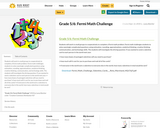
Students will work in small groups to cooperatively to complete a Fermi math problem. Fermi math challenges students to solve seemingly complicated questions using estimation, rounding, approximations, analytical thinking, creative thinking, communication, and technology skills. The students will investigate the driving question: If you wanted to send a valentine card to each person in the world next year:
• how many boxes of packaged valentines will you need to purchase?
• how much will it cost for you to purchase and mail all of the cards?
• if everyone in the world sent a valentine to everyone else in the world, how many valentines in total would be sent?
- Subject:
- Math
- Material Type:
- Activity/Lab
- Homework/Assignment
- Date Added:
- 09/11/2018
